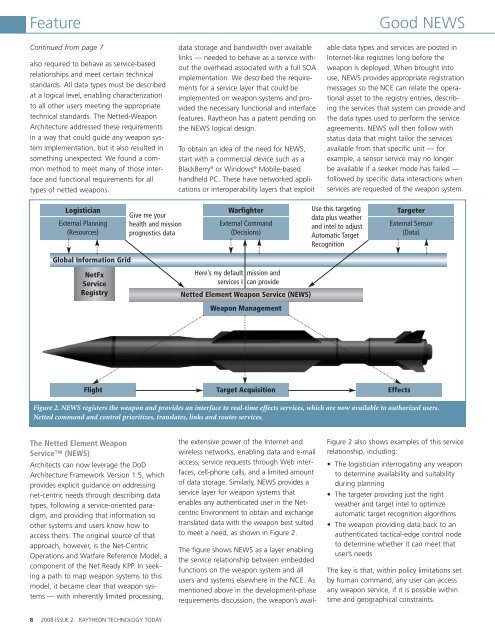2008 Issue 2 - Raytheon
2008 Issue 2 - Raytheon
2008 Issue 2 - Raytheon
Create successful ePaper yourself
Turn your PDF publications into a flip-book with our unique Google optimized e-Paper software.
Feature<br />
Continued from page 7<br />
also required to behave as service-based<br />
relationships and meet certain technical<br />
standards. All data types must be described<br />
at a logical level, enabling characterization<br />
to all other users meeting the appropriate<br />
technical standards. The Netted-Weapon<br />
Architecture addressed these requirements<br />
in a way that could guide any weapon system<br />
implementation, but it also resulted in<br />
something unexpected: We found a common<br />
method to meet many of those interface<br />
and functional requirements for all<br />
types of netted weapons.<br />
Logistician<br />
External Planning<br />
(Resources)<br />
Global Information Grid<br />
NetFx<br />
Service<br />
Registry<br />
Give me your<br />
health and mission<br />
prognostics data<br />
The Netted Element Weapon<br />
Service (NEWS)<br />
Architects can now leverage the DoD<br />
Architecture Framework Version 1.5, which<br />
provides explicit guidance on addressing<br />
net-centric needs through describing data<br />
types, following a service-oriented paradigm,<br />
and providing that information so<br />
other systems and users know how to<br />
access theirs. The original source of that<br />
approach, however, is the Net-Centric<br />
Operations and Warfare Reference Model, a<br />
component of the Net Ready KPP. In seeking<br />
a path to map weapon systems to this<br />
model, it became clear that weapon systems<br />
— with inherently limited processing,<br />
8 <strong>2008</strong> ISSUE 2 RAYTHEON TECHNOLOGY TODAY<br />
data storage and bandwidth over available<br />
links — needed to behave as a service without<br />
the overhead associated with a full SOA<br />
implementation. We described the requirements<br />
for a service layer that could be<br />
implemented on weapon systems and provided<br />
the necessary functional and interface<br />
features. <strong>Raytheon</strong> has a patent pending on<br />
the NEWS logical design.<br />
To obtain an idea of the need for NEWS,<br />
start with a commercial device such as a<br />
BlackBerry ® or Windows ® Mobile-based<br />
handheld PC. These have networked applications<br />
or interoperability layers that exploit<br />
Warfighter<br />
External Command<br />
(Decisions)<br />
Here’s my default mission and<br />
services I can provide<br />
Netted Element Weapon Service (NEWS)<br />
Weapon Management<br />
the extensive power of the Internet and<br />
wireless networks, enabling data and e-mail<br />
access, service requests through Web interfaces,<br />
cell-phone calls, and a limited amount<br />
of data storage. Similarly, NEWS provides a<br />
service layer for weapon systems that<br />
enables any authenticated user in the Netcentric<br />
Environment to obtain and exchange<br />
translated data with the weapon best suited<br />
to meet a need, as shown in Figure 2.<br />
The figure shows NEWS as a layer enabling<br />
the service relationship between embedded<br />
functions on the weapon system and all<br />
users and systems elsewhere in the NCE. As<br />
mentioned above in the development-phase<br />
requirements discussion, the weapon’s avail-<br />
Good NEWS<br />
able data types and services are posted in<br />
Internet-like registries long before the<br />
weapon is deployed. When brought into<br />
use, NEWS provides appropriate registration<br />
messages so the NCE can relate the operational<br />
asset to the registry entries, describing<br />
the services that system can provide and<br />
the data types used to perform the service<br />
agreements. NEWS will then follow with<br />
status data that might tailor the services<br />
available from that specific unit — for<br />
example, a sensor service may no longer<br />
be available if a seeker mode has failed —<br />
followed by specific data interactions when<br />
services are requested of the weapon system.<br />
Use this targeting<br />
data plus weather<br />
and intel to adjust<br />
Automatic Target<br />
Recognition<br />
Targeter<br />
External Sensor<br />
(Data)<br />
Flight Target Acquisition<br />
Effects<br />
Figure 2. NEWS registers the weapon and provides an interface to real-time effects services, which are now available to authorized users.<br />
Netted command and control prioritizes, translates, links and routes services.<br />
Figure 2 also shows examples of this service<br />
relationship, including:<br />
The logistician interrogating any weapon<br />
to determine availability and suitability<br />
during planning<br />
The targeter providing just the right<br />
weather and target intel to optimize<br />
automatic target recognition algorithms<br />
The weapon providing data back to an<br />
authenticated tactical-edge control node<br />
to determine whether it can meet that<br />
user’s needs<br />
The key is that, within policy limitations set<br />
by human command, any user can access<br />
any weapon service, if it is possible within<br />
time and geographical constraints.
















